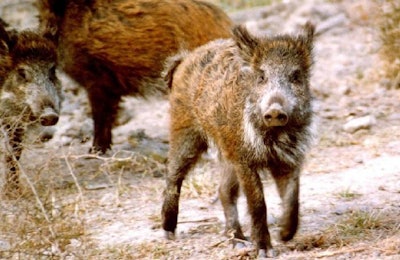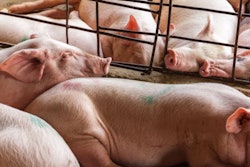
The disease is spreading to new areas on two islands of the Philippines, and has been detected in more wild boar in Russia’s Far East and in South Korea.
In the first week of February, the ASF virus was detected in Shan state, Myanmar. Six of the 10 pigs on the farm died, according to the report from the country’s animal health agency to the World Organisation for Animal Health (OIE).
December 2019 saw the most recent in a series of four confirmed ASF outbreaks in Shan state, which is in the northeast of the country. Source of the latest infection is unknown, but officials suspect the involvement of illegal animal movements, swill feeding and/or fomites (equipment and personnel).
Indonesia reports no new ASF outbreaks
There have been no new outbreaks of the disease since September 2019, according to the latest report to the OIE from Indonesia’s agriculture ministry. It refers to the disease being detected in 21 out of the 33 districts in North Sumatra province, which is three more than the previous report submitted to OIE one month ago. Of the around 1.23 million pigs in the area, the ministry says more than 38,000 have died as the result of 592 ASF outbreaks.
Rather than mass depopulation, control of ASF in North Sumatra is being achieved through biosecurity and control of pig movements, according to local sources cited by the United Nations’ Food and Agriculture Organization (FAO).
Previous reports of ASF on Bali were unfounded, reports The Jakarta Post. Agriculture minister Syahrul Yasin Limpo said the only outbreaks have been in North Sumatra, where 46,000 pigs died last year. He said the death of 800 pigs on the resort island of Bali — previously attributed to ASF — is unexplained, with lab tests still pending.
ASF spreads in the Philippines
Since the first ASF cases in July 2019 and February 4, there have been 202 confirmed outbreaks on the island of Luzon, according to the FAO. Most recent to be affected for the first time are the provinces of Benguet, Isabela and Kalinga.
New cases have been detected on the island of Mindanao, reports the same source. These include Davao city, and Davao del Sur province.
Authorities in Zamboanga city airport have seized around 220 kilograms of pig meat products that did not have veterinary certification, reports Philippine News Agency. These products originated in areas of the country where ASF has been detected, and their move to disease-free regions is banned. Zamboanga is in the far west of the island of Mindanao.
China’s new ASF control plan
China’s Central Government and State Council have announced a new three-year action plan aimed at stabilizing the production and supply of pigs after a series of damaging ASF outbreaks.
Included in the plan, according to FAO, are for the agriculture ministry to strictly implement ASF surveillance reporting, supervise the entire swine industry value chain, and continue to pilot disease prevention and control by region. It will also oversee the timely provision of depopulation subsidies; accelerate ASF vaccine research; promote standardization and large-scale pig farming; formulate guidelines for technology in animal husbandry, and accelerate the revision of animal quarantine regulations.
Vietnam estimates impacts of ASF on pork supply
This month, Vietnam’s veterinary agency has reported to the OIE that there have been no new ASF cases. According to this source, the most recent outbreak of the disease was in mid-August of 2019. A total of 5.9 million pigs have been culled to control the infection, which spread to all 63 of the country’s provinces and cities.
As a result of ASF, domestic pork supply could be 20-35% lower this year, reports Vietnam Plus.
Production would be cut from 3.9 million metric tons (mmt) to 3.15 mmt or 2.25 mmt, according to research by the Institute of Policy and Strategy for Agriculture and Rural Development. The first scenario is based on the loss of 10% of sows (about 580,000 animals), and the latter if it is assumed that 20% of the breeding herd is affected by ASF.
Shortage of supply would increase pork prices by 22% or 45%, and Vietnam would need to import 7,100 metric tons (mt), or 8,900 mt pork, respectively, under the conditions of the first and second scenario. As a result, Vietnam’s pork consumption would be likely to drop by 15% or 25%.
The Institute’s researchers called on the government to help communities build disease-free zones, encourage small-scale pig keepers to take up other enterprises, and develop safe and hygienic production methods for poultry and cattle. Meanwhile, businesses should focus on improving their competitiveness, join cooperatives, and seek new market opportunities, they said.
More wild boar afflicted in South Korea
In the border area with North Korea, a further 34 wild boar have tested positive for the ASF virus in South Korea. According to the latest report from the agriculture ministry to the OIE, these cases were confirmed in the period January 31 to February 13.
Infected animals were found in the Hwacheon and Cheorwan districts of Gangwon province, as well as Yeoncheon and Paju in Gyeonggi province.
Latest update from Yonhap news agency puts the total number of ASF-infected wild boar in South Korea at 244.
Between September and October 2019, the disease was confirmed on 14 farms, and 153,000 pigs have been slaughtered and buried to control the infection, according to the same source.
Wild boar infected in Russia’s Far East
A total of 21 wild boar have recently tested positive for the ASF virus in the Far Eastern federal district. According to the latest report from the agriculture ministry to the OIE, they were found in two locations in each of Primorsky krai and Amur oblast. Previous cases have been detected in these regions.
Russian veterinary authorities have also reported to the OIE the return of classical swine fever (CSF) to this federal district. Five cases have been confirmed in the official report to the OIE — all in Primorsky krai. Most recent cases in the area were reported in July 2019.
Since the first ASF cases in China in August 2018, the disease has been confirmed in a total of 12 Asian countries (including Russia’s Far Eastern federal district). The infection has also been reported in Europe and Africa.
View our continuing coverage of the global African swine fever situation.

















